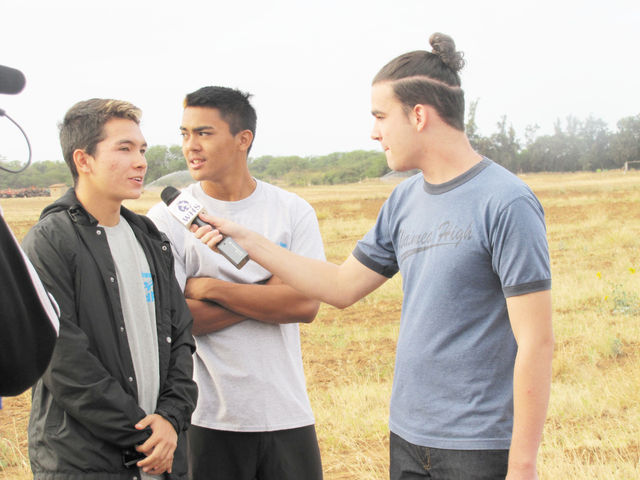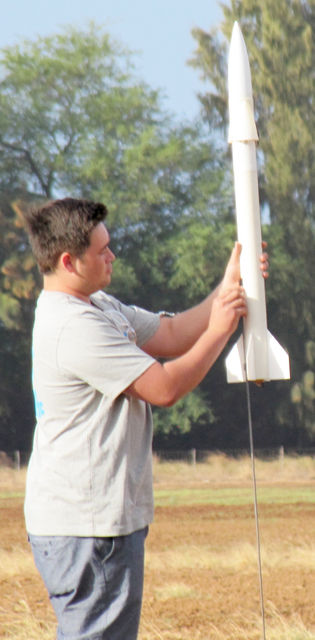Emotions filled Syngenta field Friday morning as Waimea High School students watched a rocket they’ve been designing for almost nine months fly 2,000 feet into the air. “Failure was not an option,” said Riley Saiki, “so it’s exciting and relieving;
Emotions filled Syngenta field Friday morning as Waimea High School students watched a rocket they’ve been designing for almost nine months fly 2,000 feet into the air.
“Failure was not an option,” said Riley Saiki, “so it’s exciting and relieving; every moment of every day has led to this day.”
Levi Sagucio, a Waimea High School senior, agreed.
“It’s a big weight lifted off our shoulders.”
Saiki and Sagucio are members of Video Rocketry at Waimea High School. The program is new to the school, said Jerry Nishihira, math teacher and VidRoc coordinator.
Students were chosen for the program based on math scores and started working on the rocket in June. They tested about four designs before settling on the final model.
Part of their work included testing the designs on a field on Syngenta property during weekends. At times, the test launches yielded amusing results, said Saiki.
“During one of the first launches, the wind was really strong, and it carried the rocket across the highway and into a ditch. I was the lucky one who had to go get it,” the senior said.
Another time, when the students were launching the rocket at the school’s baseball field, the wind blew it into the community swimming pool, said Elijah Nishihira, a junior.
But perhaps the most notable mishap was when the rocket caught fire.
“We pressed the button to launch it, but the rocket didn’t go up. So we pressed it again, and we noticed smoke. Then it caught fire,” said Brandon Ijima, a senior. “The fire station gave us free fire extinguishers after that.”
Those early kinks allowed the students to work out the problems, Jerry Nishihira said.
“Like with the NASA rockets, problems popped up, and they had to solve it,” he said. “The students did everything; I just supervised.”
Students learned a lot more than they realized, he added.
“There was trigonometry, geometry and meteorology components, so we wanted them to apply those skills to a real-life problem,” he said.
Briggs Agu, a senior, said he didn’t have a huge interest in rocketry before the program.
“This class piqued my interest,” he said.
Melia Okura said that a few years ago for her advanced math class, she had to build a rocket from scratch.
“My grade depended on whether or not it worked,” she said. “That was the entry way to my interest in rocketry.”
Originally, the plan was to send the rocket up with a camera, and edit the footage to make a short movie. But the principal challenged the students to aim higher, he said.
“We didn’t know if she wanted the rocket to go higher — literally, or if she was challenging us to do something bigger,” Jerry Nishihira said. “After discussing it, we decided she wanted us to aim higher.”
After doing some research, the students learned some colleges live-streamed their rocket launches. But no high school had done it. So they outfitted the rocket with a camera, transmitter and GPS.
“So we’re the first high school in the country to live-stream it,” Nishihira said.
On Friday, four members of the VidRoc video team filmed the historical moment. Nathan Gallagher led the video team in interviewing the rocketeers before the launch.
The students hope to send the footage to schools around the globe.
“We want to make these opportunities available to other high schools and start conversations,” said Justin Fune.
Elijah Nishihira added: “When we were in elementary and middle school, we didn’t have the technology, so we’re taking advantage of it now. We hope we can show other kids to take advantage of the technology they have.”
The most exciting part of the project was being able to see what they designed come to life, said Kai Lansdell.
“We were able to come up with our own design and use it,” the high school junior said. “We worked to make it a reality, and tested it; that’s what engineering is all about.”
•••
Jenna Carpenter, education reporter, can be reached at 245-0441 or jcarpenter@thegardenisland.com.




